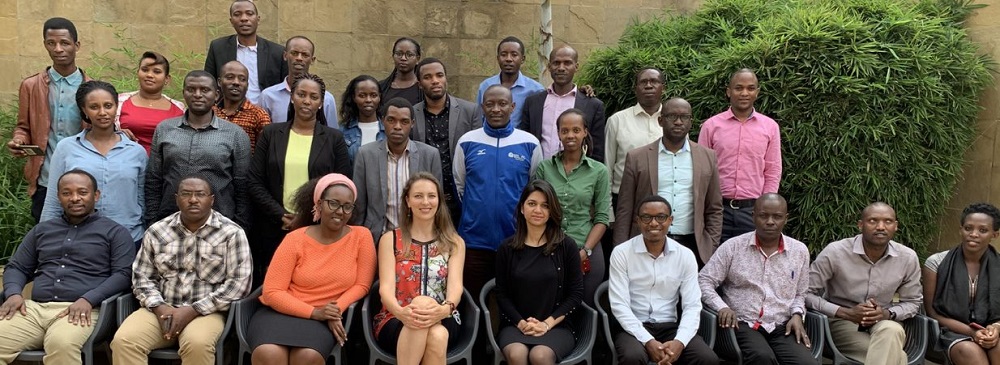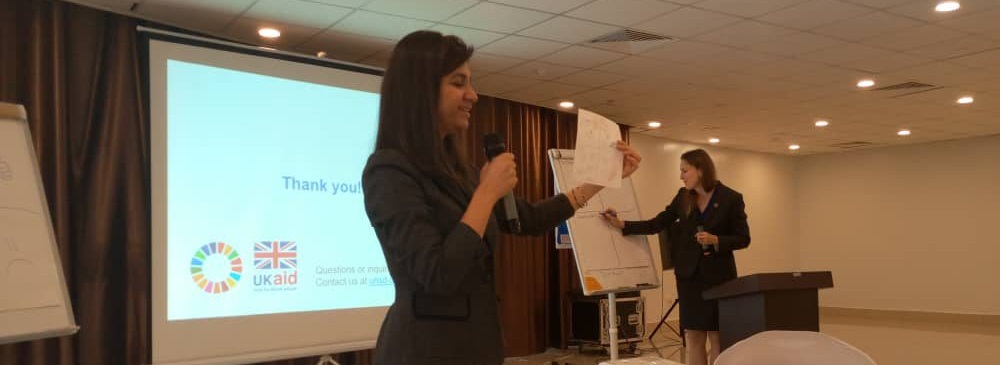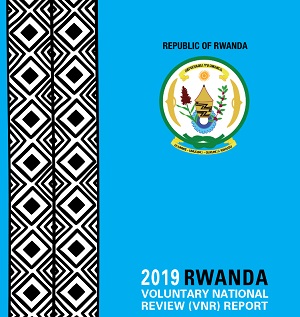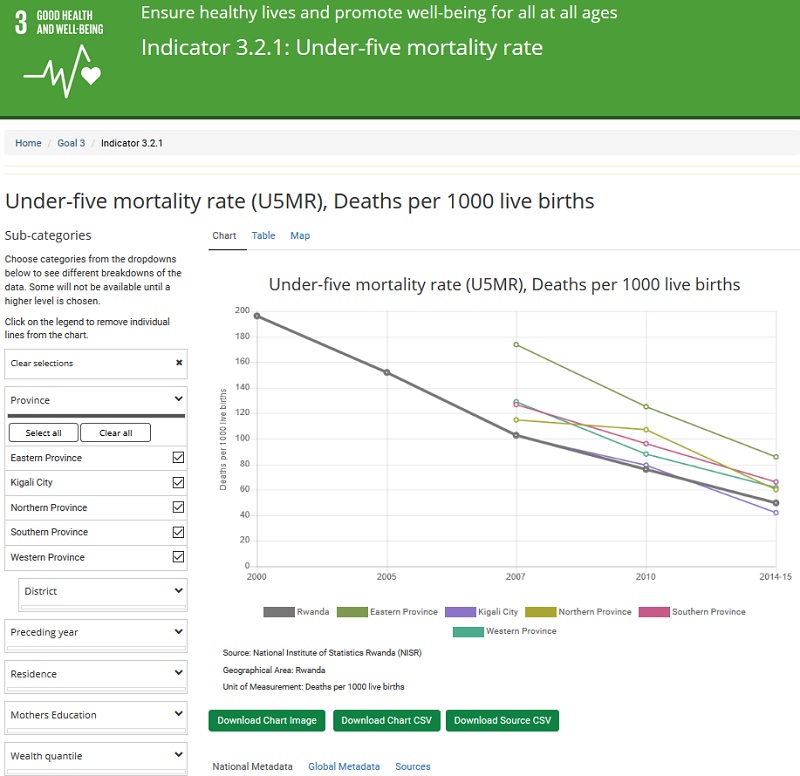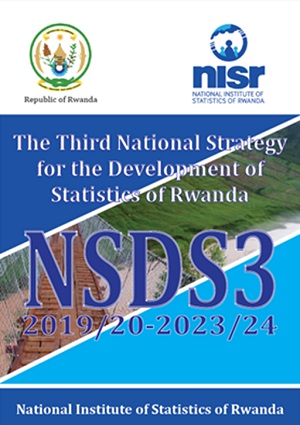Rwanda
I. General on SDG monitoring set up
National SDG organizational set up
In Rwanda, The Ministry of Finance and Economic Planning (MINECOFIN) is mandated to facilitate the ownership process of SDGs at all levels of the national structures. MINECOFIN ensures that SDGs are understood and owned both at national and local levels and across stakeholders. They continually carry out activities to mainstream and create SDGs awareness at different levels in order to deepen the ownership and awareness of SDGs amongst different and wider stakeholders. One of the key stakeholders is the National Institute of Statistics of Rwanda (NISR). NISR ensures Rwanda’s statistics are communicated clearly and concisely so that all data-users can easily access and understand them.
National set of SDG indicators
Agenda 2030 has been fully domesticated and integrated in the national planning and development framework, including Rwanda’s new long-term vision and medium-term plan (National Strategy for Transformation, 2017-2024). The SDGs indicators are mainstreamed in the mid-term strategies at national and subnational levels, which requires an overarching approach to address the interlinkages and enhance cooperation among stakeholders. The integration of the SDGs into the national development framework was guided by Government of Rwanda’s domestication roadmap approved in December 2015. The process was consultative and informed by lessons learnt from MDGs, an initial SDGs gap and data readiness analysis and the review of the Economic Development and Poverty Reduction Strategy (EDPRS 2) as well as 14 sector strategic plans. The gap analysis informed a detailed SDGs domestication plan and prioritization of new aspects brought by the adoption of the agenda 2030.
A series of stakeholder meetings were held to discuss and validate the fully contextualized list of SDGs indicators. The National SDG indicator framework is available with NISR and shows a list of all indicators applicable and not applicable to Rwanda and the responsible institutions to implement. Currently, there are 244 indicators of which 33.6% are reported, 52.9% are in the data exploratory phase, and 13.5% are not applicable to Rwanda.
SDG reports and Voluntary National Reviews
Rwanda conducted for the first time its Voluntary National Review (VNR) report on implementation of the SDGs and presented it in July 2019 at the High-Level Political Forum on Sustainable Development. This is in line with the country’s global commitment to carry out regular, voluntary and inclusive reviews of progress on the implementation of the Agenda 2030. The VNR report is centered on the proposed 2019 global theme of "Empowering people and ensuring inclusiveness and equality”. It provides an in-depth analysis of the seven SDGs (SDG 2, 4, 8, 10, 13, 16 & 17) proposed for the 2019 in-depth review across countries.
The review is structured around five thematic areas, namely:
- Human capital development
- Inclusive Economic Growth,
- Justice and Good Governance,
- Environment and Climate Change,
- Strengthening the Means of Implementation, Global partnership and Data for SDGs.
The VNR lists 111 SDG indicators in Annex 1, however, progress value for all these indicators are not reported. The report also covers other important components such as the principle of Leaving No One Behind, SDGs means of implementation, and discusses four more goals (SDG 1,3,5, and 9).
The platform is an implementation of the OpenSDG platform. The OpenSDG platform is the result of collaboration between the US government, the UK Office For National Statistics (ONS), and the nonprofit Center For Open Data Enterprise (CODE). It is easily accessible, with automatically generated visualizations to show progress over time on the SDGs. NISR has also prepared the data in SDMX format, with support from UNSD, and is now in the process of upgrading the platform to the newer version of OpenSDG.
The third National Strategy for the Development of Statistics (NSDS3) sets the agenda for statistical development in Rwanda from FY2019/20 to FY2023/24. Since its establishment in 2005, the National Institute of Statistics of Rwanda (NISR) has developed and published a wide range of data products in social, demographic and economic statistics. NSDS3 capitalises on this momentum, expanding external engagement with the National Statistical System (NSS) to strengthen Rwanda’s data value chain and promote sustainable development for all. NSDS3 is Rwanda’s first NSDS designed for alignment with the SDG agenda, leveraging the global mandate to expand data supply, mobilise resources and strengthen the NSS.
NISR led an extensive consultative process under NSDS2 to develop an official national list of localised SDG indicators. During NSDS3 implementation, the NSS aims to fulfil all relevant SDG indicator requirements. To implement a national approach to SDG measurement, NSDS3 aims to operationalise the 6 strategic areas outlined in the Cape Town Global Action Plan in the Rwandan context.
Responsibility for SDG indicator compilation
Relevant ministries and institutions are responsible for compiling respective SDG indicators. NISR provides support and share needed skills on SDGs methodology and metadata to assist in calculating indicator value.
NISR ranks first place among African countries in the 2018/19 Open Data Inventory. The Open Data Inventory (ODIN) assesses the coverage and openness of official statistics to identify gaps, promote open data policies, improve access, and encourage dialogue between national statistical offices (NSOs) and data users.
IV. Data availability and disaggregation
As of 11 December 2020, Rwanda’s SDG dissemination portal has 82 indicators reported online. This accounts for 33.64% of the total 244 indicators. Furthermore, Rwanda is currently exploring data sources for 129 indicators (52.9%). 33 indicators (13.5%) are not applicable in Rwanda’s reporting context.
Work to make more indicators available
To implement a national approach to SDG measurement, NSDS3 aims to operationalise the 6 strategic areas outlined in the Cape Town Global Action Plan in the Rwandan context, including coordination and strategic leadership on data for sustainable development, innovation and modernisation of national statistical systems, strengthening of basic statistical activities and programs, with a particular focus on the monitoring needs of the 2030 Agenda, dissemination and use of sustainable development data, multi-stakeholder partnerships for sustainable development data, and mobilise resources and coordinate efforts for statistical capacity building.
NISR has developed Rwanda SDGs Metadata handbook, providing definitions and methodology to ensure data sharing and reporting.77 metadata files have been uploaded to the OpenSDG platform.
NISR has a communication and dissemination strategy which outlines how it will perform communication and dissemination within the framework of the NSDS3 with data demands from SDGs, NSTP and other development programs at national, regional and global levels. The strategy supports the NSDS3 in the achievement of its strategic objectives to improve consumption and use of statistics for evidence-based decision making and researches; and to improve statistical literacy, advocacy and strengthen strategic partnerships. Through this strategy, the NISR launches initiatives to address the need of each category of audience by the following approaches:
- Increase the use of various channels with diversified messages,
- Strengthen communication networks and create new ones,
- Enhance the culture of innovation for communication and dissemination.
Work to make more indicators available
NISR has plans to upgrade the platform to the newest version of the OpenSDG platform.
